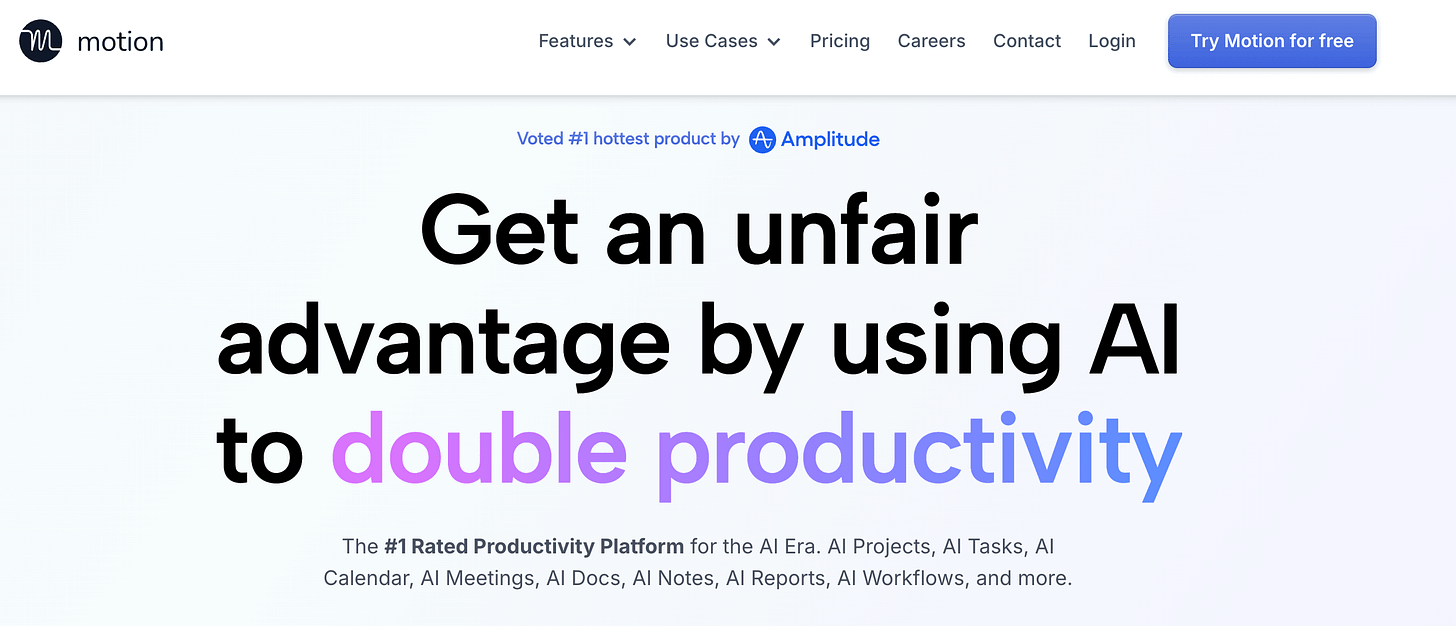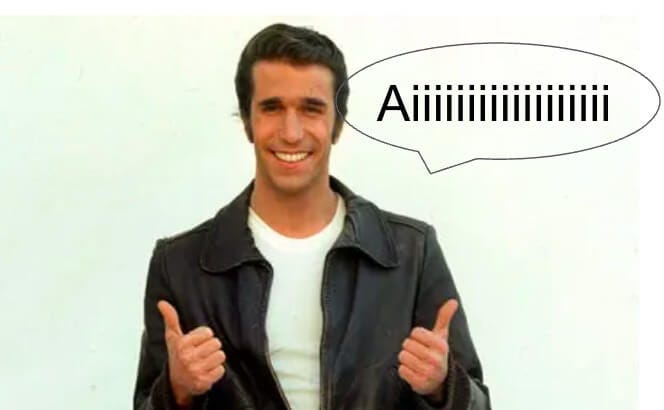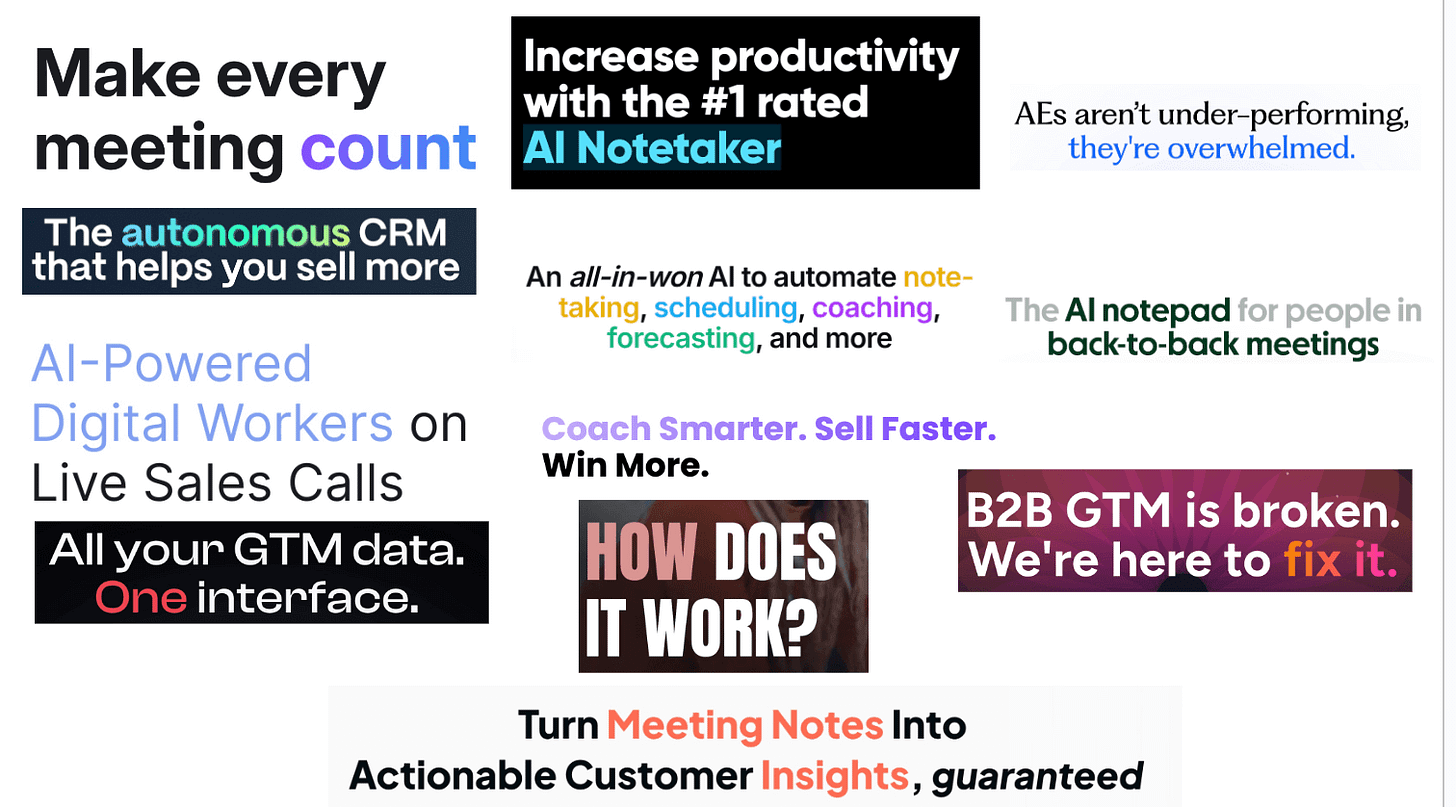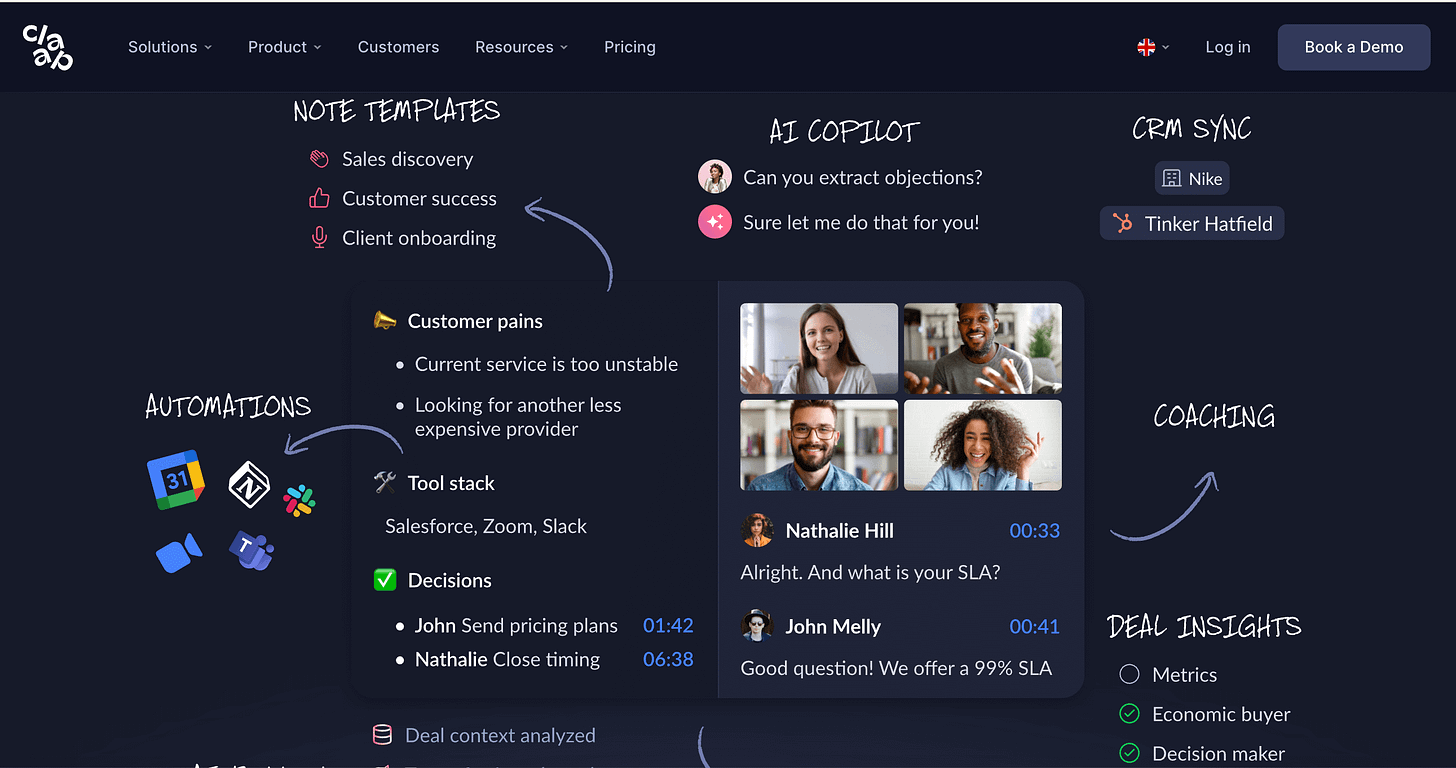The one trick to creating a world-class AI company homepage
And a great positioning story from Michelob Ultra
Hello Gobbledeers,
How’s it going? I hope you had a great break. We were up in Newport, Rhode Island (or, if you live in Maine, we were down in Rhode Island), and it’s just the best place ever. If you’ve been, I’m sure you agree. Unless you don’t, in which case I don’t want to hear about it.
Anyway, this week:
One exception the rule that repetition is a good idea in copywriting
Colour1 My World
Herpes marketing
Michelob Ultra is a positioning success story.
Onward!
If You Say Something Enough, People Will Get It
I wrote a while back that “repetition is a good copywriting technique,” and I stand by that statement.
Maybe you remember this subject line I shared from apparel brand Faherty:
That’s how I knew they had a sale. The 3rd “sale” really got me to click.
But if their homepage copy just said, “Sale shirts, sale shorts, sale pants, sale polos, sale sweaters, sale accessories, sale socks, and more,” you might think to yourself, “while yes, repetition is good, that might actually be too much repetition.”
And so I’ll amend my statement to say that “repetition is good up to a point, but after that point, you’re annoying everyone.”
Now, if you were an AI productivity tool, for example, one way you could tell people that you’re an AI productivity tool is to spell out all the things you do.
But if you did that, how would they know that you’re AI-powered, which is obviously something that seems to be important to today’s buyers. Also to companies that are keyword-stuffing their homepages in hopes of getting picked up in ChatGPT searches.
Which is the only explanation I can think of for why AI productivity tool Motion thought that this was a good subhead:
I’m guessing they used AI to quintuple the number of times they wrote “AI” on that page.
True Colors, Shining Through
I’m working with a client on a homepage messaging project (hint hint, I’m at jared@sagelett.com…is that enough marketing for myself? Marketing myself is very uncomfortable for me. Trust me, I’m better at re-doing your homepage messaging than I am at trying to get you to bring me on to help you with your homepage messaing. And really, isn’t that a better choice than someone who is great at marketing themselves but kinda meh at the homepage stuff? Yes. Yes it is.), and as part of that project I’ve gone through the websites of roughly infinity AI-powered sales tools (and I’ve probably still missed infinity of them), and I’ve noticed something.
Maybe 3 months ago, we started seeing AI-first companies make their websites black, with light text. Then we saw some movement away from that, and it looks like most of the companies I saw had white backgrounds (I know, this is fascinating).
But just recently I’ve started to see that companies are using colored text to call out a word or phrase. This is a new thing:
Sometimes it’s a gradiant (that’s fun!) and sometimes it’s one color, and sometimes it’s a bunch of words in a bunch of colors (like that “all-in-won AI” example - ugh). Sometimes it highlights what it is (“AI Notetaker,”) and sometimes something allegedly unique about it (“autonomous”) and sometimes it appears to be random (“count.”)
What I’m saying is that if you want to show your prospects that you’re a modern AI-first company, you should randomly color in 1, possibly 2 words on your homepage headline. You’re welcome.
It’s Just So Simple…Claap Edition
Before working on this project, I hadn’t heard of AI sales tool Claap. But now I have. Putting aside that Claap’s name used to be slang for venereal disease, I’d rather have one of several venereal diseases than try to figure out what their homepage is trying to tell me:
Now, in fairness that’s not the top of their homepage (the top of their homepage is “Your sellers/10x Amplified.”) But it’s right below the headline on their homepage, and let me just note that there is a LOT going on there. It seems to be 10x amplified from what anyone would suggest you put on your homepage.
My point is that even if your platform has a bunch of functionality in it, there’s a point at which your buyer is not thinking to themselves, “gee, that’s a lot of functionality” and is instead thinking, “Who the hell is Tinker Hatfield?”
Remember, your prospect doesn’t know your platform yet. Don’t overwhelm them, John Melly.
Speaking of Venereal Diseases…
If you have not seen the video from the Cannes Lions award-winning campaign for “New Zealand: The Best Place in the World to Have Herpes,” you are missing out.
The New Zealand Herpes Foundation (for real?) wanted a campaign that would de-stigmatize having herpes, which (apparently?) 80% (what???) of New Zealanders suffer from.
Well, suffer no more. Or something.
Enjoy the 90 seconds:
(Look - I’ll be honest. Did I type “you’ll be sore-ly disappointed if you don’t watch the video?” I did. I typed those words…I’m a dad. So yes, I thought, “you’ll be sore-ly disappointed” was funny. I still do - I’m not ashamed to admit that. But I respect you too much to leave it in there. You’re welcome.)
Successful Beer Positioning: Michelob Ultra Edition
Way back in the first issue or so of Gobbledy, I quoted advertising pioneer David Ogilvy, who wrote:
‘‘The positioning must be decided before the advertising is created.”
If Gobbledy is about anything, it’s about that idea: if you do not decide what market you fit in, how you are better than the competition in that market, and who would be interested in buying your product because of that difference, you are going to be screwed, marketing-wise.
I can understand why maybe people are less convinced of that in Software World (tm), because maybe you’re thinking that if you put up booths at enough conferences and have enough SDRs send enough emails, that you’ll be able to close enough people to raise the next round of funding.
Maybe? I guess? Maybe?
But probably not.
You definitely cannot do that if you are a consumer-facing brand. I’ve talked here about beer marketing in the past because while, yes, some beers are different than other beers, many beers are the same, and they position themselves differently by price point (Bud Light is a light beer for people who want to drink mid-priced beers…until it somehow also became a sign that you support progressive political ideas…until it wasn’t that anymore either?).
But if you’re the brand manager for a beer, you need to figure out where there is space in the market for you to exist, and who would be interested in that space, and why.
A few years back I wrote about Schaefer Beer, which had an incredibly successful 20+ year run using a jingle as the foundation of its marketing:
Schaefer (which was a popular beer in the Northeast, a fact that could explain why you’ve never heard of it…also because it’s all-but-disappeared) did some research (likely after having a few beers at lunch) and decided that they would target frequent beer drinkers. And not just frequent beer drinkers - beer drinkers who like to have a bunch of beers when they sit down (or stand up….or fall over) to have a drink.
Their target was “people who like to have a bunch of beers all at once.” And while that may seem insane now, for whatever reason it wasn’t considered insane then. In fact, they wrote a jingle emphasizing their positioning:
“Schaefer is the one beer to have/when you’re having more than one.”
So the way the Schaefer marketers thought about the world, there had previously been no beer really focused on people who drank a lot of beer.
This is a good idea in virtually every market, of course - think about who would purchase the most amount of your product, then try to sell to those people. I mean, duh, yes, of course. But also, that’s not actually how things play out in the real world.
But maybe you are a clever marketer and think to yourself, “There’s plenty of beer out there for people who drink beer. And people nowadays don’t drink as much as they used to because of health reasons. How do we capture the part of the market where we can focus on people who drink LESS beer, but somehow make it so it seems like beer is in some non-specific way actually - maybe - kinda good for you?”
Well, I think you would do a few things:
You wouldn’t call yourself “light” or “lite” beer, because that it associated with being a somewhat lower calorie version of a thing that isn’t good for you, and because people have shied away from “diet” versions of other things (see the growth of Coke Zero and the decline of Diet Coke).
You would find an occasion for drinking the beer that is not currently associated with drinking beer, as all of those occasions are already taken by other beers.
You would find a target group that might think to themselves that beer is something they have earned, rather than something to get them through the misery of a hard day of work.
Behold, Michelob Ultra. A beer that is “light” in the sense that it has fewer calories than other beers, but is not a “light” beer. The marketing touts the lower carbohydrates, rather than the lower calories. And - maybe most importantly - they have positioned it as a way for non-professional athletes to reward themselves after a sporting activity.
Why am I telling you this? Because in a beer market where the market leaders have all seen revenue shrink over the past year (Bud Light is down 9%!), Michelob Ultra is up 3%. And it’s now the number 2 selling beer in the US (behind Modelo, which has struggled as Hispanic Americans have reduced their spending, and now ahead of previous number 2 Bud Light).
As the article I linked to points out, health concerns + Ozempic + cannabis + canned cocktails = bad beer market.
But only if you’re selling to people where you are trying to convince them to replace one beer with another beer.
If you’ve found an area of growth - running, biking, pickleball, ultimate frisbee, or whatever padel is - and you’ve latched onto that and convinced those people to add some Michelob Ultra into their sporting routine, then you’ve brewed a recipe for success.
The article also quotes a beer distributor touting the growth of Michelob Ultra and saying that one reason he thinks it’s been successful is because the brand has “stuck to its focus on health and wellness, and the consistency has paid off.”
Which is also something we talk about here all the time - launching new campaigns from scratch is super fun if you’re a marketer. But you know what’s even more fun? Keeping your job because you’ve found something that works and stick with it.
As always, thanks for reading to the end - it’s the best part.
P.S. - I haven’t shared my Calendly link in a while…I’m happy to chat with Gobbledy readers. You working on a messaging thing and just want to run something by someone? Career advice? Can’t figure out what color to change that one word on your homepage to? Happy to chat: Here’s the link to set up some time to chat.
Why did Chicago spell “colour” that way in the title of that song? They’re American. Were they being cute? Funny? Did they spell it wrong? Did they think having a flute-based rock song gave them permission to spell “colour” in a more British-English-proper kinda way?







Well, this is disappointing:
“This article was amended on 4 July 2025. An earlier version said that up to 80% of New Zealanders are affected by genital herpes at some point in their lives; however, this figure relates to both genital and oral herpes.”
Not saying one type of herpes is superior. But oral heroes could use some better positioning.
fun (?) fact: NZ herpes infection rate is the same as in the US.